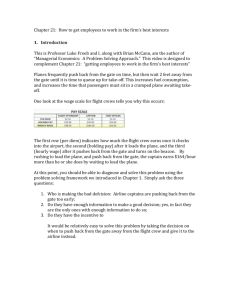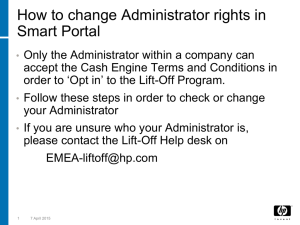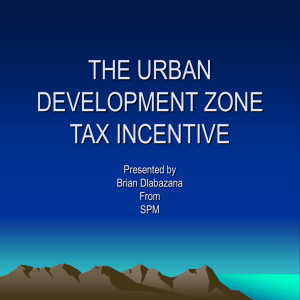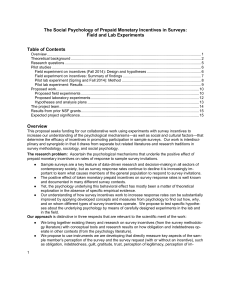Froeb_21 - Vanderbilt Business School
advertisement
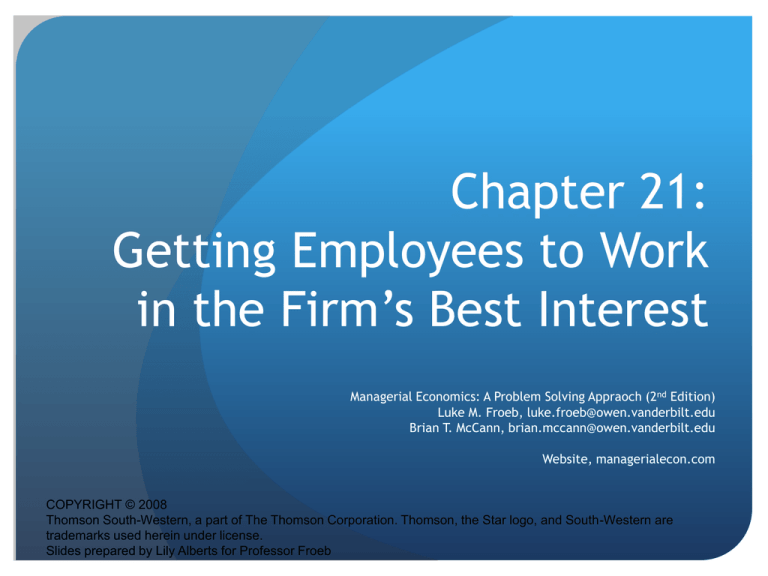
Chapter 21: Getting Employees to Work in the Firm’s Best Interest Managerial Economics: A Problem Solving Appraoch (2nd Edition) Luke M. Froeb, luke.froeb@owen.vanderbilt.edu Brian T. McCann, brian.mccann@owen.vanderbilt.edu Website, managerialecon.com COPYRIGHT © 2008 Thomson South-Western, a part of The Thomson Corporation. Thomson, the Star logo, and South-Western are trademarks used herein under license. Slides prepared by Lily Alberts for Professor Froeb Summary of main points • Principals want agents to work for their (the principals’) best interests, but agents typically have different goals than do principals. This is called incentive conflict. • Incentive conflict leads to adverse selection (“which agent do I hire?”) and moral hazard (“how do I motivate agents?”) when agents have better information than principals. • Three approaches to controlling incentive conflict are • Fixed payment and monitoring (shirking, adverse selection, and monitoring costs), • incentive pay and no monitoring (must compensate agents for bearing risk with a risk premium), or • sharing contracts and some monitoring (some shirking and some risk sharing which leads to lower risk premium). Summary of main points (cont.) • In a well-run organization, decision makers have • (1) the information necessary to make good decisions and • (2) the incentive to do so. • If you decentralize decision-making authority, you should strengthen incentive compensation schemes. • If you centralize decision-making authority, you should make sure to transfer specific knowledge (information) to the decision makers. Summary of main points (cont.) • To analyze principal–agent conflicts, focus on three questions: • Who is making the (bad) decisions? • Does the employee have enough information to make good decisions? • Does the employee have the incentive (performance evaluation + reward system) to make good decisions? • Alternatives for controlling principal–agent conflicts center on one of the following: • Reassigning decision rights (to someone with better incentives or information) • Transferring information • Changing incentives (performance eval. + reward system) Introductory anecdote: ASI • Auction Service International (ASI) employed art experts to convince owners of valuable art to use auction services to sell their artwork. • The auction house profited by charging the art owners a percentage of the sell price at auction. • This percentage was negotiated by the young art experts. • A problem arose, the negotiated prices (“commissions” to the auction house), which were supposed to be between 10 and 30%, were consistently low, near 10%. • The CEO of ASI began investigating this phenomenon and found that the art experts were “trading” low prices for kickbacks from the art owner. • Discussion: What are two possible solutions for this problem? Principal-Agent Relationships • When studying firm-employee relationships we use principal-agent models. • Definition: A principal wants an agent to act on her behalf. But agents often have different goals and preferences than do principals. • The auction house is a principal; the art expert is an agent. • Note: for convenience only, we adopt the linguistic convention of referring to principals as female and agents as male. Incentive Conflict • Because the agent has different incentives than the principal, the principal must manage the incentive conflict, which comes down to two problems with which you should by now be familiar: • Adverse selection: the principal has to decide which agent to hire • Moral hazard: once hired, the principal must find a way to motivate the agent. • Both problems are caused by asymmetric information: adverse selection implies that only the agent knows his “type”; while moral hazard means that only the agent knows how much effort he is exerting. • The costs of addressing moral hazard and adverse selection are known as agency costs, because they are often analyzed by principal-agent models. Agency Costs • A principal can reduce agency costs if she gathers information (reduces information asymmetry) • about the agent’s type (adverse selection); or • about the agent’s actions (moral hazard). • Information gathering: • To mitigate adverse selection problems, firms can run background checks on agents before they are hired. • To mitigate moral hazard problems, firms can monitor an agent’s behavior while working. • This difference in timing leads to the characterization that adverse selection is a pre-contractual problem, while moral hazard is a post-contractual problem. Incentive Pay vs. Risk • Incentive pay can help align the incentives of employees (agents) with the goals of the organization (principal). • For example, if harder work leads to higher sales, then create incentives by tying the employee’s reward to sales performance, e.g., with a sales commission. • But incentive pay also imposes risk on agents. • Commissions mean a portion of an agent’s compensation is dependent on factors beyond the agent’s control, e.g., weather. • Agents must be compensated for taking on this additional risk. • So, incentive compensation represents a tradeoff: • Does the benefit (harder work by agent) outweigh the cost (extra compensation for bearing risk)? Controlling incentive conflict • In an ideal organization • Decision-makers have all the information necessary to make profitable decisions; and • The incentive to do so. • When designing an organization, you should consider how to structure the following three items. • Decision rights: who should make the decisions? • Information: is the decision-maker provided with enough information to make a good decision? • Incentives: does the decision-maker have the incentive to do so. Incentives are created by linking performance evaluation and reward systems (rewarding good performance). Decision Rights and Information • Who should make decisions? • Decentralize decision making: move decision rights down in the hierarchy, closer to those with better information; or • Centralize decision making: move decision rights up in the hierarchy, closer to those with better incentives. • If you decentralize decision-making authority, you should also strengthen incentive-compensation schemes. • If you centralize decision-making, find a way to transfer information to those making decisions. Incentives (performance + reward) • Performance evaluation • Informal: using subjective performance evaluation, or • Formal: using objective measures such as sales or accounting profit, stock price, relative performance metrics. • Rewards: Decide how compensation is tied to performance evaluation. • Reward good performance and/or penalize bad performance. • Examples: bonus, increased probability of promotion, faster promotion. Example: Marketing vs. Sales • Sales and marketing divisions often have incentive conflict • Sales wants to maximize revenue, i.e., make all sales where MR > 0 • Marketing wants to maximize profit, i.e., make all sales where MR > MC. • In other words, sales prefers a higher level of sales and a lower price than does marketing. • For example, a large telecommunications equipment company that serves government agencies that buys telecom equipment. • Sales people want to bid more aggressively to make sure that they win the contract (they care about maximizing sales) • Marketing wants the sales agents to bid less aggressively, so that when they do win, the contracts are more profitable (they care about maximizing profit). Marketing vs. Sales (cont.) • Two solutions: • Centralize bidding decisions to marketing; and try to transfer enough information to marketing managers so they know how aggressively to bid. • Decentralize bidding decisions (keep decision rights with the sales people) and change incentives – Instead of a 10% commission on revenue, give sales people a 20% commission on profit, (revenue neutral if the contribution margin is 50%) • Discussion: How well do threshold compensation schemes work, e.g., a bonus if you open hit a target sales number. • Discussion: How well do high-powered sales commissions work, e.g., 5% commission for sales of $1M; 10% commission on sales of $2M, work? Example: Franchising • Incentive conflict exists between franchisors (McDonalds) and its franchisees. McDonalds wants big franchise fees and high quality at franchisees to protect its reputation. Franchisees want smaller fees and lower quality (cheaper). • McDonalds has both company owned stores and franchisees. • In a company-owned store, both adverse selection and moral hazard are concerns – managers don’t work as hard as they would if they owned the restaurant, and a salaried manager position might attract lazy workers. • Franchisees have bigger incentive to work hard (because they are the “residual claimants” of profit), but they are also exposed to more risk. Franchisees have to be compensated (lower franchise fees) for bearing risk. Franchising (cont.) • Another option is to use a sharing contract: instead of a fixed franchise fee, the franchisor might demand a percentage of the revenue or profit of the restaurant. • This arrangement reduces franchisee risk by reducing the amount the franchisee pays to the franchisor when the store does poorly. • Sharing contracts may also encourage shirking because the franchisee no longer keeps every dollar he earns. • DISCUSSION: Why does McDonalds use companyowned stores along freeways, but franchises in towns? Diagnosing and solving problems • To analyze principal-agent problems, begin with the bad decision that is causing the problem, and then ask three questions. 1. Who is making the (bad) decision? 2. Did agent have enough information to make a good decision? 3. Did agent have the incentive to do so, i.e., how is the employee evaluated and compensated? • Answers to these questions generally suggest alternatives for reducing agency costs. You can, • • • Let someone else make the decision, or Change the information flow, or Change the incentives. Example: Declining Store Profits • The CEO of a large retail chain of “general stores” that target low-income customers has noticed that newly opened stores are not meeting sales projections. • What is the problem here? And how can it be fixed? • Some helpful information about the stores is, • The company uses development agents to find new store locations and negotiate the leases with property owners – the company rewards these agents with generous bonuses (stock options) if they open fifty new stores in a single year. • Agents are supposed to open new stores only if their sales potential is at least one million dollars per year, but recently opened stores earn half this much. • What is the problem; and what is the solution? Alternate Intro Anecdote • Whaling ventures in the 1800s were managed by agents, who would purchase supplies, hire a captain and crew, and plan the voyage on behalf of the investors. • Agent’s performance difficult for investors to observe or evaluate • Actions of crew on multi-year voyages even more difficult to evaluate • Contracts and organizational forms century evolved in response to these problems • Most whaling enterprises were closely held by a small number of local investors • Ownership rights were allocated to create powerful incentives for their managers • Agents usually held substantial ownership shares in their ventures Alternate Intro Anecdote (cont.) • Attempting to run these ventures via corporation form in the 1830s and 1840s failed • They paid their crews the same ways, used similar vessels, and employed agents with similar responsibilities • Only main difference was in ownership structures and hierarchical governance • They were unable to create the incentives requisite for success in the industry. The managers of these corporations, who did not hold significant ownership stakes, did not perform as well as their peers in unincorporated ventures. 21 1. Introduction: What this book is about Managerial Economics 2. The one lesson of business 3.Benefits, costs and decisions Table of contents 4. Extent (how much) decisions 5. Investment decisions: Look ahead and reason back 6. Simple pricing 7.Economies of scale and scope 8. Understanding markets and industry changes 9. Relationships between industries: The forces moving us towards long-run equilibrium 10. Strategy, the quest to slow profit erosion 11. Using supply and demand: Trade, bubbles, market making 12. More realistic and complex pricing 13. Direct price discrimination 14. Indirect price discrimination 15. Strategic games 16. Bargaining 17. Making decisions with uncertainty 18. Auctions 19.The problem of adverse selection 20.The problem of moral hazard 21. Getting employees to work in the best interests of the firm 22. Getting divisions to work in the best interests of the firm 23. Managing vertical relationships 24. You be the consultant EPILOG: Can those who teach, do?



